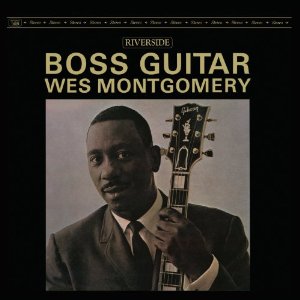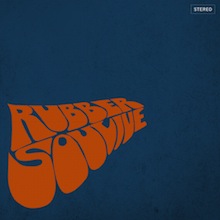Home » Jazz Articles » Multiple Reviews » Wes Montgomery, Soulive and the Beatles: Bending Time
Wes Montgomery, Soulive and the Beatles: Bending Time
 Wes Montgomery
Wes Montgomery Boss Guitar
Riverside / OJC Remasters
2010 (1963)
The guitar/organ trio was already thought by some to be anachronistic in 1963, when Montgomery, organist Mel Rhyne and drummer Jimmy Cobb recorded Boss Guitar. Though similar lineups, often augmented by a tenor saxophonist, were still a staple of lounge entertainment in urban America, the glory days of hard bop, when the trios led by organist Jimmy Smith seemed almost cutting edge, were fading fast, as first the Beatles and then acid rock seized the time.
Despite this, Montgomery's albums in the style gained credibility in jazz circles, for the quality of the leader's improvisations and for the general musicianship of all the players involved. Between 1959 and 1963, Montgomery made three albums with guitar, organ and drums for the Riverside label, on which he emerged as the guitar innovator of his generation—A Dynamic New Jazz Sound (1959) and Boss Guitar and Guitar On The Go (both 1963). The organist on all three discs was Mel Rhyne, whose understated approach was the antithesis of that favored by the flamboyant, rococo Smith, and was heavily influenced by Montgomery's style. Rhyne was Montgomery's regular organist on the club dates around his hometown, Indianapolis, on which the guitarist continued to focus his career even after his national breakthrough with The Incredible Jazz Guitar Of Wes Montgomery (Riverside, 1960). It wouldn't be until the second half of the decade, first on Verve, then on A&M, that Montgomery's AOR popularity compelled exposure in bigger, international settings, by which time his music had little to do with jazz.
Boss Guitar is the most enduring of Montgomery's guitar/organ trio discs—partly because, in the three and a half years since his recording debut with Montgomery, Rhyne had developed exponentially as a soloist; partly because of the presence of Cobb, a recent graduate of trumpeter Miles Davis' band; but above all, because of the vibrant air of engagement, mirrored by Montgomery's animated expression on the front cover (in a photo which grows more magical the longer it's looked at), which runs through the music.
A few years later, and up until his premature death in 1968, Montgomery more or less abandoned improvised music, instead performing radio-friendly set-pieces, often sweetened by strings, and exchanging jazz and Broadway standards for more contemporary material, including that written or popularized by the Beatles. Which brings us to Rubber Soulive....
 Soulive
Soulive Rubber Soulive
Royal Family Records
2010
...Which is where the timewarps really kick in. Soulive—guitarist Eric Krasno, organist and pianist Neal Evans and drummer Alan Evans—is a jam band which has been active for 10 years, and which, like most jam bands, is at heart retro-modern. The trio's recorded oeuvre is a varied one, and Rubber Soulive—which sounds almost as though it was recorded live, in perhaps a 1960s Detroit lounge (rather than an upstate New York recording studio a few months ago)—finds it at its most groove-jazz and R&B focused.
The most explicit timewarp, of course, is the material. This isn't the complete reading of the Beatles' Rubber Soul (EMI, 1965) that the title suggests, though it does include that album's "Drive My Car" and "In My Life," but is instead a wider selection of 11 John Lennon/Paul McCartney and George Harrison songs from the second half of the Beatles' career. There are plenty of inventive, albeit brief improvisations, but Soulive make little attempt to "reinvent" the tunes, preferring instead to recast them with respect as jazz/rock/groove instrumentals—just like countless groove-jazz groups were doing during the Beatles' heyday.
Another temporal distortion is in the performances themselves. This is by three musicians, apparently unmediated by digital technology or radical post production, performing much as a prototypical blues-rock band might have done in the late 1960s: that is to say, directly, unfussily and with more adrenalin than nuance. That impression is strengthen by the effects and pedals, limited in textural scope, used by Krasno and Neal Evans, which sound, and presumably are, much the same as those in use 40 years ago. Retro? Or timeless? Whatever. Though modest in ambition, this is honest, exhilarating music.
Standout tracks are "Eleanor Rigby" (which Wes Montgomery would include on his 1967 A&M album A Day In The Life) and "While My Guitar Gently Weeps." The pathos of the original "Eleanor Rigby," transformed by Soulive into flaming intensity towards its conclusion, is brilliantly evoked; and the shimmering beauty of "While My Guitar Gently Weeps" is winningly respun by Krasno, over keyboard textures reminiscent of Marco Benevento, the Supreme Time Lord.
Tracks and Personnel
Boss Guitar
Tracks: Besame Mucho; Dearly Beloved; Days Of Wine And Roses; The Trick Bag; Canadian Sunset; Fried Pies; The Breeze And I; For Heaven's Sake; Besame Mucho; The Trick Bag; Fried Pies.
Personnel: Wes Montgomery: guitar; Mel Rhyne: Hammond B-3 organ; Jimmy Cobb: drums.
Rubber Soulive
Tracks: Drive My Car; Taxman; In My Life; Eleanor Rigby; I Want You (She's So Heavy); Come Together; Something; Revolution; Help!; Day Tripper; While My Guitar Gently Weeps.
Personnel: Eric Krasno: guitar; Neal Evans: Hammond organ, piano; Alan Evans: drums.
< Previous
South Beach
Comments
Tags
Wes Montgomery
Multiple Reviews
Chris May
United States
Soulive
Mel Rhyne
Jimmy Cobb
Jimmy Smith
Miles Davis
Paul McCartney
George Harrison
Marco Benevento
For the Love of Jazz
 All About Jazz has been a pillar of jazz since 1995, championing it as an art form and, more importantly, supporting the musicians who create it. Our enduring commitment has made "AAJ" one of the most culturally important websites of its kind, read by hundreds of thousands of fans, musicians and industry figures every month.
All About Jazz has been a pillar of jazz since 1995, championing it as an art form and, more importantly, supporting the musicians who create it. Our enduring commitment has made "AAJ" one of the most culturally important websites of its kind, read by hundreds of thousands of fans, musicians and industry figures every month.



















